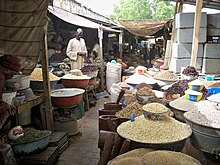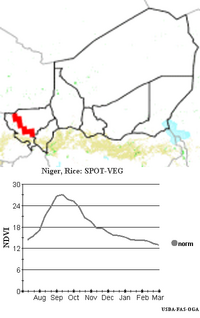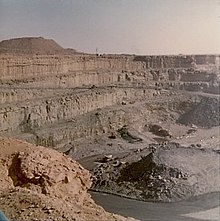Economy of Niger
 Petit Marché in Niamey | |
| Currency | West African CFA franc (XOF) |
|---|---|
| Statistics | |
| GDP | $11.63 billion (2011 est.) |
GDP growth | 2.3% (2011 est.) |
GDP per capita | $800 (2011 est.)(PPP, 176th) |
GDP by sector | agriculture: 39%; industry: 16.3%; services: 41.6% (2011 est.) |
| 2.9% (2011 est.) | |
Population below poverty line | 63% (1993 est.) |
| 34 (2007) | |
Labour force | 4.688 million (2007) |
Labour force by occupation | agriculture: 90%; industry: 6%; services: 4% (1995) |
Main industries | uranium mining, cement, brick, soap, textiles, food processing, chemicals, slaughterhouses |
| External | |
| Exports | $786 million (2006) |
Export goods | uranium ore, livestock, cowpeas, onions |
Main export partners | |
| Imports | $1.68 billion (2012) |
Import goods | Rice, machinery, vehicles and parts, petroleum, cereals |
Main import partners | |
Gross external debt | $1.342 billion (31 December 2011 est.) |
| Public finances | |
| Revenues | $1.385 billion (includes $134 million from foreign sources) |
| Expenses | $1.609 billion (2011 est.) |
All values, unless otherwise stated, are in US dollars. | |
The economy of Niger is based largely upon internal markets, subsistence agriculture, and the export of raw commodities: foodstuffs to neighbors and raw minerals to world markets. Niger, a landlocked West African nation that straddles the Sahel, has consistently been ranked near the bottom of the Human development index, with a relatively low GDP and per capital income. Economic activity centres on subsistence agriculture, animal husbandry, re-export trade, and export of uranium. The 50% devaluation of the West African CFA franc in January 1994 boosted exports of livestock, cowpeas, onions, and the products of Niger's small cotton industry. Exports of cattle to neighboring Nigeria, as well as Groundnuts and their oil remain the primary non-mineral exports. The government relies on bilateral and multilateral aid – which was suspended briefly following coups d'état in 1996 and 1999 – for operating expenses and public investment. Short-term prospects depend on continued World Bank and IMF debt relief and extended aid. The post 1999 government has broadly adhered to privatisation and market deregulation plans instituted by these funders.
Macro-economic trend
This is a chart of trend of gross domestic product of Niger at market prices estimated by the International Monetary Fund[3] with figures in millions of CFA Francs.
| Year | Gross Domestic Product | US Dollar Exchange | Inflation Index (2000=100) |
|---|---|---|---|
| 1980 | 530,000 | 211.23 CFA Francs | 46 |
| 1985 | 647,100 | 449.37 CFA Francs | 69 |
| 1990 | 675,596 | 272.26 CFA Francs | 61 |
| 1995 | 938,800 | 499.09 CFA Francs | 87 |
| 2000 | 1,280,372 | 710.13 CFA Francs | 100 |
| 2005 | 1,841,244 | 527.12 CFA Francs | 113 |
Mean wages were $0.37 per man-hour in 2008
.
Overall

Niger's economy is based largely on subsistence crops, livestock, and some of the world's largest uranium deposits. Drought cycles, desertification, a 3.4% population growth rate and the drop in world demand for uranium have undercut an already marginal economy. Traditional subsistence farming, herding, small trading, and informal markets dominate an economy that generates few formal sector jobs. Between 1988 and 1995 28% to 30% of the total economy of Niger was in the unregulated Informal sector, including small and even large scale rural and urban production, transport and services.[4]
GDP per capita
Current GDP per capita[5] of Niger grew 10% in the 1960s. But this proved unsustainable and it consequently shrank by 27% in the 1980s and a further 48% in the 1990s. Much of this GDP is explained through the exploitation of uranium at Arlit in the far north of the country. Ore is partially processed on site by foreign mining corporations and transported by truck to Benin. Fluctuation of GDP can be mapped to changes in international uranium price, as well as price negations with the main mining company, France's Areva NC. Price rises in the mid-1970s were followed by a collapse in the market price through much of the 1980s and 1990s. Thus the GDP per capita has little direct impact on the average Nigerien, although uranium funds much government operation. The 2006 Human Development Index ranked Niger sixth from worst in the world, with a HDI of 0.370: 174 of 179 nations.[6]
Agriculture


Niger's agricultural and livestock sectors are the mainstay of all but 18% of the population. Fourteen percent of Niger's GDP is generated by livestock production (camels, goats, sheep and cattle), said to support 29% of the population. The 15% of Niger's land that is arable is found mainly along its southern border with Nigeria. Rainfall varies and when insufficient, Niger has difficulty feeding its population and must rely on grain purchases and food aid to meet food requirements. Although the rains in 2000 were not good, those in 2001 were plentiful and well distributed. Pearl millet, sorghum, and cassava are Niger's principal rain-fed subsistence crops. Irrigated rice for internal consumption, while expensive, has, since the devaluation of the CFA franc, sold for below the price of imported rice, encouraging additional production. Cowpeas and onions are grown for commercial export, as are small quantities of garlic, peppers, potatoes, and wheat. Groundnuts, and to a lesser degree Cotton, introduced by former colonial power France in the 1930s and 1950s respectively, account for most of the world market for Nigerien industrial agriculture. Prior to the mass exploitation of uranium in the early 1970s, groundnut oil was the largest Nigerien export by worth.[8]
The majority of Niger's population are rural residents engaged in agriculture, mostly in the south centre and south west of the nation. While these people are dependent on the agricultural market portions of their production and consumption, much of Nigerien farming is subsistence agriculture outside of the marketplace.[8]
External trade and investment


Of Niger's exports, foreign exchange earnings from livestock, although impossible to quantify, are second only to those from uranium. Actual exports far exceed official statistics, which often fail to detect large herds of animals informally crossing into Nigeria. Some hides and skins are exported and some are transformed into handicrafts.
Mining
The persistent uranium price slump has brought lower revenues for Niger's uranium sector, although uranium still provides 72% of national export proceeds. The nation enjoyed substantial export earnings and rapid economic growth during the 1960s and 1970s after the opening of two large uranium mines near the northern town of Arlit. When the uranium-led boom ended in the early 1980s, however, the economy stagnated and new investment since then has been limited. Niger's two uranium mines (SOMAIR's open pit mine and COMINAK's underground mine) are owned by a French-led consortium and operated by French interests.

Exploitable deposits of gold are known to exist in Niger in the region between the Niger River and the border with Burkina Faso. Substantial deposits of phosphates, coal, iron, limestone, and gypsum also have been found. Numerous foreign companies, including American firms, have taken out exploration licenses for concessions in the gold seam in western Niger, which also contains deposits of other minerals.
Several oil companies explored for petroleum since 1992 in the Djado plateau in north-eastern Niger and the Agadem basin, north of Lake Chad but made no discoveries worth developing at the time. In June 2007, however, China National Petroleum Corporation (state-owned by the People's Republic of China) signed a US$5 billion agreement to extract oil in the Agadem block, as well as build a 20,000 barrels (3,200 m3) per day oil refinery and a 2,000 km oil pipeline in the country; production is expected to start in 2009.[9]
Niger's known coal reserves, with low energy and high ash content, cannot compete against higher quality coal on the world market. However, the parastatal SONICHAR (Société nigérienne de charbon) in Tchirozerine (north of Agadez) extracts coal from an open pit and fuels an electricity generating plant that supplies energy to the uranium mines.

Economic growth
After the economic competitiveness created by the January 1994 CFA franc devaluation contributed to an annual average economic growth of 3.5% throughout the mid-1990s, the economy stagnated due the sharp reduction in foreign aid in 1999, which gradually resumed in 2000, and poor rains in 2000. Reflecting the importance of the agricultural sector, the return of good rains was the primary factor underlying a projected growth of 4.5% for 2001.
Foreign investment
In recent years, the Government of Niger promulgated revisions to the investment code (1997 and 2000), petroleum code (1992), and mining code (1993), all with attractive terms for investors. The present government actively seeks foreign private investment and considers it key to restoring economic growth and development. With the assistance of the United Nations Development Programme (UNDP), it has undertaken a concerted effort to revitalize the sector.
Currency
Niger shares a common currency, the CFA franc, and a common central bank, the Central Bank of West African States (BCEAO), with six other members of the West African Monetary Union. The Treasury of the Government of France supplements the BCEAO's international reserves in order to maintain a fixed rate of 100 CFA (Communauté Financière Africaine) to the French franc (to the euro as of January 1, 2002).
Government restructuring
In January 2000, Niger's newly elected government inherited serious financial and economic problems including a virtually empty treasury, past-due salaries (11 months of arrears) and scholarship payments, increased debt, reduced revenue performance, and lower public investment. In December 2000, Niger qualified for enhanced debt relief under the International Monetary Fund program for Highly Indebted Poor Countries and concluded an agreement with the Fund on a Poverty Reduction and Growth Facility (PRGF).
In addition to changes in the budgetary process and public finances, the new government has pursued economic restructuring towards the IMF promoted privatization model. This has included the privatization of water distribution and telecommunications and the removal of price protections for petroleum products, allowing prices to be set by world market prices. Further privatizations of public enterprises are in the works. In its effort comply with the IMF's Poverty Reduction and Growth Facility plan, the government also is taking actions to reduce corruption and, as the result of a participatory process encompassing civil society, has devised a Poverty Reduction Strategy Plan that focuses on improving health, primary education, rural infrastructure, and judicial restructuring.
Foreign Aid
The most important donors in Niger are France, the European Union, the World Bank, the IMF and other United Nations agencies (UNDP, UNICEF, FAO, WFP, and UNFPA). Other principal donors include the United States, Belgium, Germany, Switzerland, Canada, and Saudi Arabia. While USAID does not have an office in Niger, the United States is a major donor, contributing nearly $10 million each year to Niger’s development. The U.S. also is a major partner in policy coordination in such areas as food security and HIV/AIDS. The importance of external support for Niger's development is demonstrated by the fact that about 45% of the government's FY 2002 budget, including 80% of its capital budget, derives from donor resources. In 2005 the UN drew attention to the increased need for foreign aid given severe problems with drought and locusts resulting in a famine endangering the lives around a million people.
Statistics
GDP: purchasing power parity - $9.6 billion (9.6 G$) (1999 est.)
GDP - real growth rate: 2% (1999 est.)
GDP - per capita: purchasing power parity - $1,000 (1999 est.)
GDP - composition by sector:
agriculture:
40%
industry:
18%
services:
42% (1998)
Population below poverty line: 63%
Household income or consumption by percentage share:
lowest 10%:
3%
highest 10%:
29.3% (1992)
Inflation rate (consumer prices): 4.8% (1999)
Labour force: 70,000 receive regular wages or salaries
Labour force - by occupation: agriculture 90%, industry and commerce 6%, government 4%
Unemployment rate: NA%
Budget:
revenues:
$377 million, including $146 million from foreign sources
expenditures:
$377 million, including capital expenditures of $105 million (1999 est.)
Industries: uranium mining, cement, brick, textiles, food processing, chemicals, slaughterhouses
Industrial production growth rate: 5.1% (2003 est.)
Electricity - production: 180 GWh (1998)
Electricity - production by source:
fossil fuel:
100%
hydro:
0%
nuclear:
0%
other:
0% (1998)
Electricity - consumption: 363 GWh (1998)
Electricity - exports: 0 kWh (1998)
Electricity - imports: 196 GWh (1998)
Agriculture - products: cowpeas, cotton, peanuts, pearl millet, sorghum, cassava (tapioca), rice; cattle, sheep, goats, camels, donkeys, horses, poultry
Exports: $269 million (f.o.b., 1997)
Exports - commodities: uranium ore 65%, livestock products, cowpeas, onions (1998 est.)
Exports - partners: US, Greece, Japan, France, Nigeria, Benin
Imports: $295 million (c.i.f., 1997)
Imports - commodities: consumer goods, primary materials, machinery, vehicles and parts, petroleum, cereals
Imports - partners: France, Ivory Coast, US, Benelux, Nigeria
Debt - external: $1.3 billion (1999 est.)
Economic aid - recipient: $222 million (1995)
Currency: 1 Communauté Financière Africaine franc (CFAF) = 100 centimes
Exchange rates:
Communauté Financière Africaine francs (CFAF) per US$1 – 670 (January 2000), 560.01 (January 1999), 589.95 (1998), 583.67 (1997), 511.55 (1996), 499.15 (1995)
note:
since 1 January 1999, the CFAF is pegged to the euro at a rate of 655.957 CFA francs per euro
Fiscal year: calendar year
See also
- List of companies based in Niger
- List of countries by percentage of population living in poverty
- List of countries by Human Development Index
- List of countries by GDP (nominal)
- List of countries by GDP (nominal) per capita
- List of countries by GDP (PPP)
- List of countries by GDP (PPP) per capita
- List of countries by GNI (nominal) per capita
- List of countries by GDP growth
- List of countries by industrial production growth rate
References
- ^ . The Observatory of Economic Complexity. 2012 http://atlas.media.mit.edu/country/ner/. Retrieved 2014-01-26.
{{cite web}}: Missing or empty|title=(help) - ^ "Import Partners of Niger". The Observatory for Economic Complexity. 2012. Retrieved 2014-01-26.
- ^ IMF, 2006 estimates
- ^ C. Maldonado & J. Gasarian. SECTEUR INFORMEL: FONCTIONS MACRO-ECONOMIQUES ET POLITIQUES GOUVERNEMENTALES: LE CAS DU NIGER. Document de recherche S-INF-1-20. Département du développement des entreprises et des coopératives, Organisation internationale du Travail -- OIT (1998).
- ^ earthtrends.wri.org
- ^ Human Development Report 2007/2008. United Nations Development Program.
- ^ a b www.pecad.fas.usda.gov/cropexplorer/
- ^ a b Decalo, Samuel (1997). Historical Dictionary of the Niger (3rd ed.). Boston & Folkestone: Scarecrow Press. ISBN 0-8108-3136-8.
- ^ "Niger set to become oil producer". BBC News. 2007-06-03. Retrieved 2008-06-07.
External links
- Template:Dmoz
- Invest in Niger: Centre de Promotion des Investissements Sis à la Chambre de Commerce d'Agriculture, d'Industrie et d'Atisanat du Niger.
- http://www.niger-tourisme.com: Ministère du tourisme et de l'artisanat nigérien.
- Niger latest trade data on ITC Trade Map
- The MBendi website, Niger: A South Africa-based business research group. Is especially useful for tracking government mining concessions.
- LA MAISON DE L'AFRIQUE: Niger. Franco-African business group.
- Institut de Recherche pour le Développement au Niger: French government development office in Niger.
- United Kingdom Department of International Development:Niger.
- Canadian International Development Agency:Niger.
- World Trade Organization MEMBER INFORMATION: Niger.
- The World Bank, Niger overview and resources.
- International Monetary Fund: Article IV Executive Board Consultation reports regarding Niger.
- IMF. Niger: Financial Position in the Fund as of January 31, 2008.
- IMF. Niger: Transactions with the Fund from May 01, 1984 to January 31, 2008.
- Estruscan Mining (Canada): corporate report on their Samira Hill Gold Mine, on the Benin border.
- West African Agricultural Market Observer/Observatoire du Marché Agricole (RESIMAO), a project of the West-African Market Information Network (WAMIS-NET), provides live market and commodity prices from fifty seven regional and local public agricultural markets across Benin, Burkina Faso, Ivory Coast, Guinea, Niger, Mali, Senegal, Togo, and Nigeria. Sixty commodities are tracked weekly. The project is run by the Benin Ministry of Agriculture, and a number of European, African, and United Nations agencies.

